SEO
What Is Marketing Automation & How to Get Started?
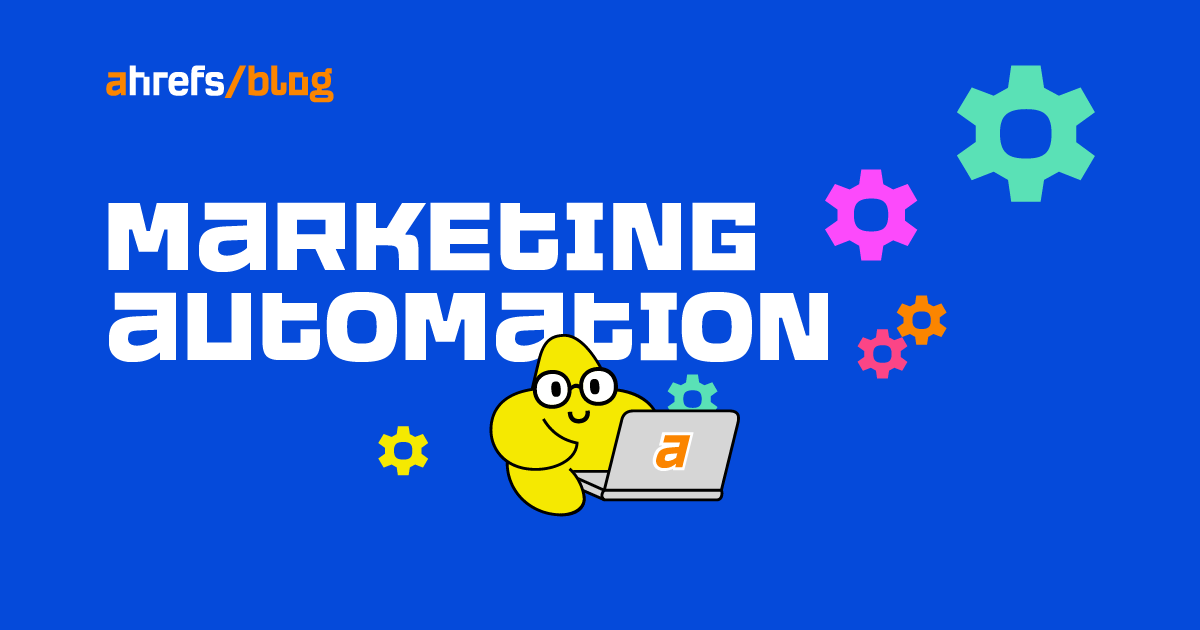
Marketing automation is a must for any marketer, no matter the size of their company. It doesn’t matter whether you sell products or services. Those who ignore marketing automation are missing out on powerful resources.
According to EmailMonday, around 56% of companies use some form of marketing automation, and 40% of B2C companies plan to adopt the technology.
But marketing automation can be overwhelming, with so many different platforms, integrations, and services available. How do you know what works best for your business?
Don’t worry. You’re not alone.
In this guide, we’ll go through the following:
Let’s start by defining marketing automation.
Marketing automation uses software, tools, or processes to automate repetitive tasks. This frees up time for more important tasks or increases efficiency. Automation can be used as part of an overall marketing strategy or for standalone tactics, such as email marketing, lead generation, sales, social media management, alerts, analytics, and reporting.
There are five main benefits of marketing automation. Here’s how it helps marketers and businesses.
1. Save time and money
The main benefit of marketing automation is it can save time and money because it automates repetitive tasks, such as sending emails or social media posting, which can reduce marketing expenditure.
For example, the University of Buenos Aires saved 28 employee salaries and $100,000 per annum by automating its student communication.

2. Increased sales
Marketing automation can increase sales, as it allows companies to scale their marketing efforts across multiple touchpoints, campaigns, and channels at the right time.
This sports nutritionist generated $50,000 in eight weeks by adding exit-intent automation.

3. Higher lead conversion
Drift reported that 58% of B2B companies don’t respond to sales leads. To combat this issue, marketers can improve sales funnels by automating initial and follow-up touches with prospects and customers, leading to higher revenue.

4. Improved engagement or customer service
Automation helps customer service by handling many customer requests or issues in real-time. It is possible to create automated responses to common questions, such as “What is my order status?” or “How do I use Ahrefs’ Content Explorer?”
5. Better analysis and reporting
Automation can provide marketing teams access to data, information, or insights that are easier to interpret.
For example, Ahrefs’ Rank Tracker contains information that integrates with this Google Data Studio report that lets you monitor your Google rankings and competitors.

Now let’s take a look at examples of marketing automation.
Here are some examples from marketers who use automation to help them improve different aspects of their businesses.
Drip campaigns
Drip campaigns are a series of emails automatically delivered over time that tell a story or educate prospects about a solution or problem.
Here’s an example: Blair Enns, who helps marketing agencies with pricing strategies, created a drip campaign to persuade people to buy his book.

After you opt in to get a free sample of his book, he sends you a series of emails based on his core message: “Charge more, buy my book.”

Outreach campaigns
Link building agencies use automation to follow up on prospects and earn more links from their outreach campaigns.
Here are the typical steps in an outreach campaign:
- Find prospects’ contact details
- Craft your pitch
- Outreach to prospects
- Secure links
According to Postaga, the average response rate for an initial email is 16%, and sending at least one follow-up will get a response rate of 27% on average.
So if you send 1,000 outreach emails and include one automated follow-up, that’s 110 more replies and link possibilities.
Sales conversion campaigns
I spoke to Adam Watson, the co-founder of Hollywood Mirrors, about automation.

Here’s his reply:
We automate emails depending on the customer behavior on the site.The customer gets the right email at the right time with the right offer.
We sent over one million automated emails last year from a small list, and they produce 25% of our total revenue.
One of five automated campaigns is triggered if the website captures an email address depending on on-site behavior.
- Welcome series — for subscribers who recently subscribed.
- Cart abandonment — those who add to the cart but don’t complete the purchase.
- Browse abandonment — subscribers who browse products but don’t purchase.
- Win back campaign — dormant customers who haven’t purchased recently.
- VIP automation — aimed at high or frequent spenders.
Automation helps with all KPIs such as conversion, sales, repeat orders, and customer lifetime value. The more a customer sees your brand over time, the more likely they will buy.
Another sales conversion automation example
Automation can also notify customers and staff about sales promotions, orders, shipping, and deliveries.
At the Nike.com shop, I added this product to my basket and then received this automated “Complete your purchase before we run out of your size” message.

I most certainly do not wish to miss out on this garment.
Chatbots
A website chatbot is an automated tool that can interact with visitors in real-time via text messages, emails, or phone calls. It can also automatically answer questions from visitors.
The Ahrefs chatbot provides visitors easy access to the Ahrefs Academy, help information, and chat with support staff.
When you click “send us a message,” the chatbot interprets your message and proposes relevant help pages.

If the help articles aren’t enough to answer your question, you can talk to Ahrefs support staff.

Alerts and notifications
An alert is a notification sent by a website owner whenever someone performs a specific action. For example, if someone joins your newsletter, you can email them to thank them for subscribing.
Last year, we launched Ahrefs Webmaster Tools, a free tool to help you get more out of your website.
Once you’ve verified a website and the domain is added to the dashboard, you can create automated backlink, keyword, Site Audit, and ranking notifications.
Click the three dots next to the domain name, then choose which notifications you wish to receive.

WordPress uses automation to notify you about comments posted on your website and enable plugin updates, saving web designers, developers, and bloggers time.

For invoicing purposes, I use Harvest to send out invoices. If the customer pays via Stripe or PayPal, automation sends me a payment notification and the customer receives a thank-you email.
In addition, I can set up the invoice settings so that slow payers get friendly reminders every seven days until they have paid.

Leads and appointments
If you promote services on your website, the aim is to collect information from site visitors, specifically those interested in your services.
This lead qualification automation asks website visitors a series of questions and aims to book an appointment with serious prospects. But the automation doesn’t put off those who aren’t ready to speak to a company representative yet.

In this example, here are the four questions a visitor is asked.
Question 1. What help do you need?

Question 2. What is your website built on?

Question 3. What is your budget?

Question 4. When are you looking to start?

If the prospect is a highly qualified lead, they are invited to book a call.

A less-qualified lead can sign up for a newsletter.

This automation enables marketers to get immediate and future leads from their websites.
Personalization
Automated personalization allows marketers to tailor their messages to specific individuals instead of sending the same message to everyone.
I sent subscribers a personalized website audit using Ahrefs’ Batch Analysis tool and ConvertKit custom fields.
I sent 262 subscribers a personalized email containing:
- Their Domain Rating (DR).
- The number of referring domains.
- The number of keywords they ranked for.
- Organic traffic.

Here’s the step-by-step process:
- Export subscribers from ConvertKit into Google Sheets
- Select Data > Split text to columns to get their domain name from their email address
- Copy and paste domain names into the Batch Analysis tool to extract the website metrics
- Create new columns in Google Sheets for the DR, referring domains, keywords, organic traffic data
- Match this data with subscribers
- Create custom fields in ConvertKit for the domain name, referring domains, keywords, organic traffic information
- Import Google Sheet information back into ConvertKit
- Create an email broadcast
- Insert the custom fields into the email body copy to personalize each subscriber’s domain name, referring domains, keywords, and organic traffic information
Segment customers
Customer segmentation is the process of grouping together customers based on similar behaviors, interests, or needs.
For example, you can create rules aimed at people who open emails and then tag them by a product they’ve bought or a page they’ve visited.
Here, we can see that people who visit and start to exit this spreadsheet website receive a pop-up message with segmentation options.

Upon selecting the “I’m new to Excel” option, I see that the website shows the “get 3 video lessons for beginners” offer.

Now the site owner can tailor follow-up content and offers aimed at their “beginner” customer segment.
Email triggers
An email trigger sends designated content to prospects or customers who take action on your site (e.g., sign up for a free trial, make a purchase, or raise a support request).
These emails confirm that your business noticed the customer’s request or action.
While most email marketing tools and automation platforms can trigger automatic emails, 49% of marketers don’t use these tools. So using these features gives you a competitive advantage.
Let’s say you sell training courses on a platform, such as Teachable or Podia.
After a customer buys your training course, you can send the order details to a marketing platform, such as Drip, ConvertKit, Mailchimp, etc., through an integration.

When the order details come through the marketing platform, you can trigger an automation that emails the customer a welcome email and then another email 14 days later to check on their progress in the training course they signed up for.

PPC and retargeting
Automated PPC bidding is when an advertiser bids automatically based on their budget and other criteria to make managing advertising campaigns easier.
Automated retargeting is when you display ads to people who have just visited your website to encourage them to return.
1250ships.com, an e‑commerce website, created a Google remarketing ad in Mailchimp that generated over $8,200 in revenue and gained 19 new customers—leading to a 3,879% ROI in the first three months.
And here’s how you can create a Google remarketing advert with Mailchimp.
Reports
Automation can generate specific reports for specified people, dates, and times.
You can create automated reports for customers, clients, or staff within Google Analytics.
For example, here’s how to create a report showing all channel traffic:
- Go to Google Analytics > Acquisition
- All Traffic > Channels
- Click the arrow next to the date range > Tick “Compare to the previous period” > Apply

- Click the share button > Customize the email report options

Additionally, Google Search Console sends regular performance reports each month.
Onboarding
Onboarding is the process of bringing users up to speed with your product/service as quickly as possible.
It’s about making sure they feel welcome and confident enough to use, purchase, and keep using your product/service.
Over the festive break, I considered migrating my website from WordPress to the Ghost CMS.
Here’s the Ghost onboarding process for trial customers.

I purchased a custom theme but changed my mind and canceled the trial period.
The ConvertFlow onboarding process is more comprehensive than Ghost’s, including a video course, case studies, results, and techniques.

While I have abandoned interest in these services, I still receive valuable emails from both brands.
Social media
Automated social media uses software to post updates about a business on social media sites like Facebook, Twitter, LinkedIn, etc.
Marketers can do this manually, but it’s much more efficient if done automatically.
We use MeetEdgar to automate posting and content distribution on our main social channels; you can learn more about Ahrefs’ marketing stack in our very own Mateusz Makosiewicz’s guide.
It’s now time to put what you’ve learned about automation into practice.
If you’re new or want to automate more, here’s our seven-step guide to get started.

Step 1. Goal
Define a specific goal. Note that certain goals—such as saving time or money and increasing sales, leads, conversions, or engagement—are too broad. You need to examine things more closely.
For example, let’s say you looked at Google Analytics and discovered that 1.7% of traffic becomes a lead.
But after delving deeper, you discover you don’t convert many of these leads into paying clients.
Thus, one of your main goals can be to increase qualified leads or increase your conversion rates between the lead and customer stages.
Step 2. Identify technology
Take a look at the technology you are currently using.
Are there options available to reuse the existing technology to reach your goals?
Are there resources you’re not using or could be using?
For example, if you generate leads but do not convert them, is your team following up on those leads?
Could you speak to the sales team that interacts with prospects and build an automated sequence that answers the key questions sales leads have?
Step 3. Look externally
Look how others in your industry are automating parts of their businesses.
I used Ahrefs’ Content Explorer to find automation case studies rather than Google when researching this article.
Type “automation” AND “industry” (replace “industry” with your industry name) into the tool and sort by date.

You’ll discover many examples and case studies specific to your industry that you can learn from.

If you don’t believe your existing solutions or tools can help solve your issues or achieve your goal, look elsewhere.
For example, I’m comparing the templates offered by ConvertFlow and RightMessage because I believe their technology can help increase and convert more qualified leads than my current solution.


Most marketing automation tools will offer demonstrations, free trials, or “recipes” to help you decide if they are right for you.
Step 4. Map out the process
If you need to map out a process from scratch, use a mind-mapping tool like Xmind or MindMeister to visualize each user’s step.
This process for qualifying leads has already been mapped out.
However, there’s no educational and conversion process in place after the visitor subscribes to the newsletter.
Here’s an example of the process to generate qualified website leads.
- Define pages that prospects visit
- Create form, fields, and CTA
- Create a page, web form, and email reply
- Connect form submission with CRM by creating Zapier integration
- Set up a trigger to send follow-up emails
- Create relevant content for the email sequence
Step 5. Build, test, launch
After mapping out your process, it’s time to build the automation.
Most SaaS automation software lets you visually design the automation; if that fails, get your development team involved instead.
Then test out your process; for example, if you’re automating cart abandonment, go to Chrome Incognito and add a product to the basket:

Then abandon the order and ensure the automation works the way it’s supposed to:

Step 6. Measure
Measuring performance against the last 30 days is usually the most accurate way, and most automation solutions have methods for measuring.
Step 7. Repeat
After tackling one problem or goal, repeat the process by identifying another problem or goal.
Final thoughts
This article covered everything about marketing automation.
Automating repetitive marketing activities can help you save time and money; improve sales, leads, customer services, and engagement; and allow marketers to focus on higher-priority tasks.
The best approach is to start by automating small marketing tasks first, then move on to more significant tasks. You should also check out how to build a martech stack and what online marketing tools Ahrefs uses.
Got questions? Ping me on Twitter.
SEO
How to Find and Use Competitor Keywords
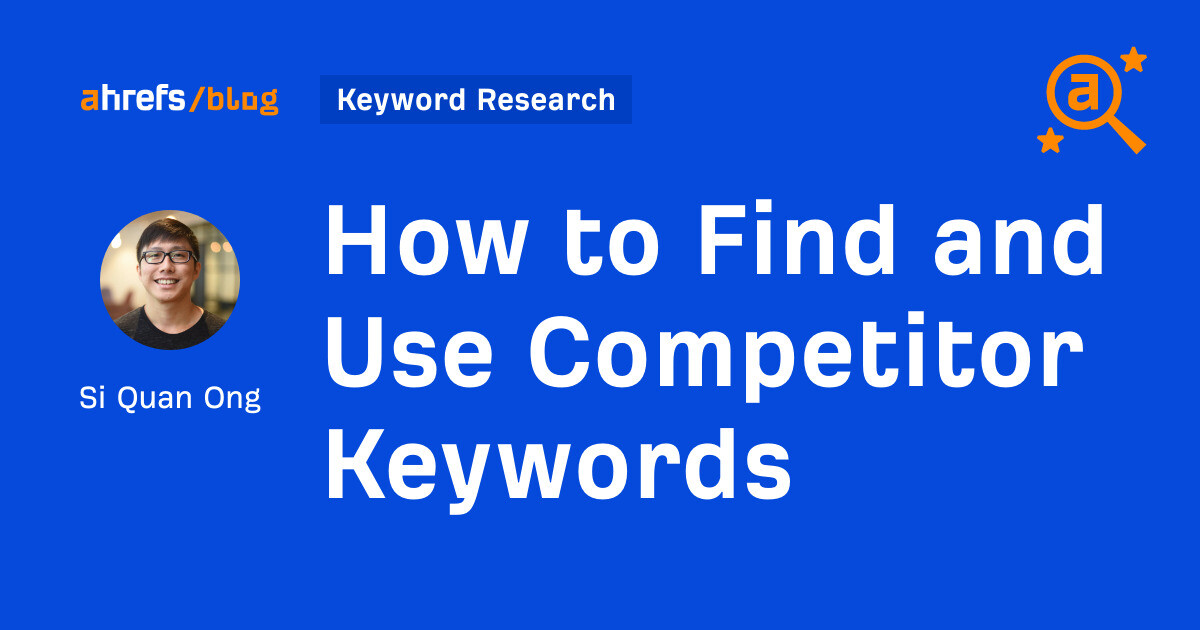
Competitor keywords are the keywords your rivals rank for in Google’s search results. They may rank organically or pay for Google Ads to rank in the paid results.
Knowing your competitors’ keywords is the easiest form of keyword research. If your competitors rank for or target particular keywords, it might be worth it for you to target them, too.
There is no way to see your competitors’ keywords without a tool like Ahrefs, which has a database of keywords and the sites that rank for them. As far as we know, Ahrefs has the biggest database of these keywords.
How to find all the keywords your competitor ranks for
- Go to Ahrefs’ Site Explorer
- Enter your competitor’s domain
- Go to the Organic keywords report
The report is sorted by traffic to show you the keywords sending your competitor the most visits. For example, Mailchimp gets most of its organic traffic from the keyword “mailchimp.”


Since you’re unlikely to rank for your competitor’s brand, you might want to exclude branded keywords from the report. You can do this by adding a Keyword > Doesn’t contain filter. In this example, we’ll filter out keywords containing “mailchimp” or any potential misspellings:
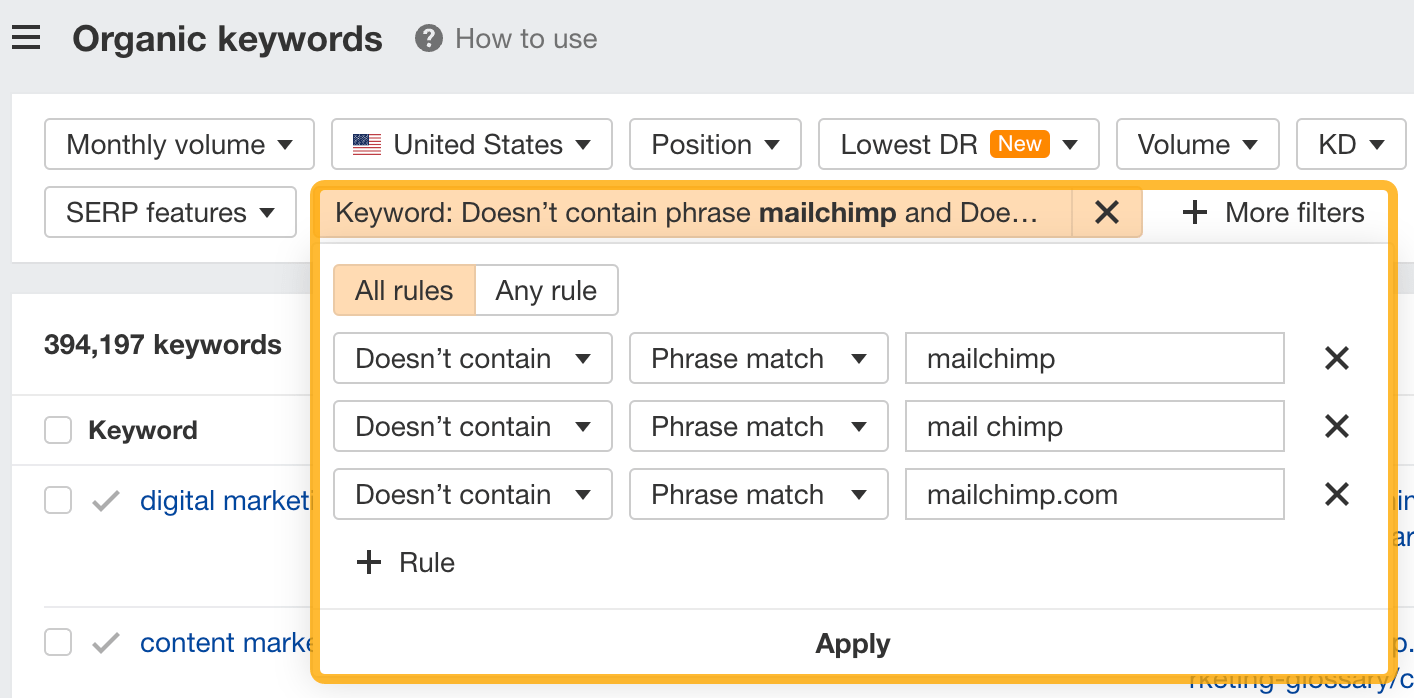

If you’re a new brand competing with one that’s established, you might also want to look for popular low-difficulty keywords. You can do this by setting the Volume filter to a minimum of 500 and the KD filter to a maximum of 10.
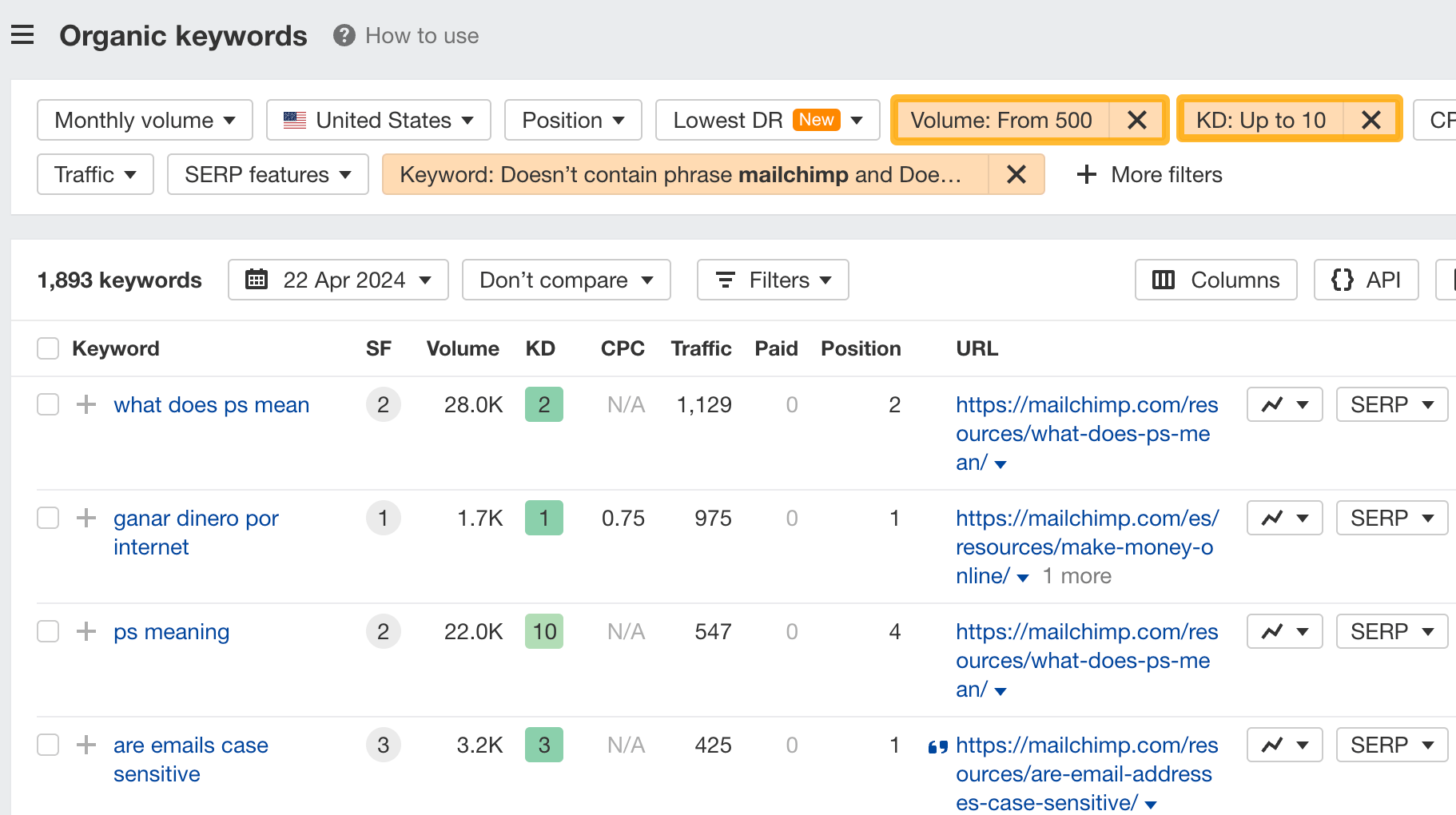

How to find keywords your competitor ranks for, but you don’t
- Go to Competitive Analysis
- Enter your domain in the This target doesn’t rank for section
- Enter your competitor’s domain in the But these competitors do section


Hit “Show keyword opportunities,” and you’ll see all the keywords your competitor ranks for, but you don’t.
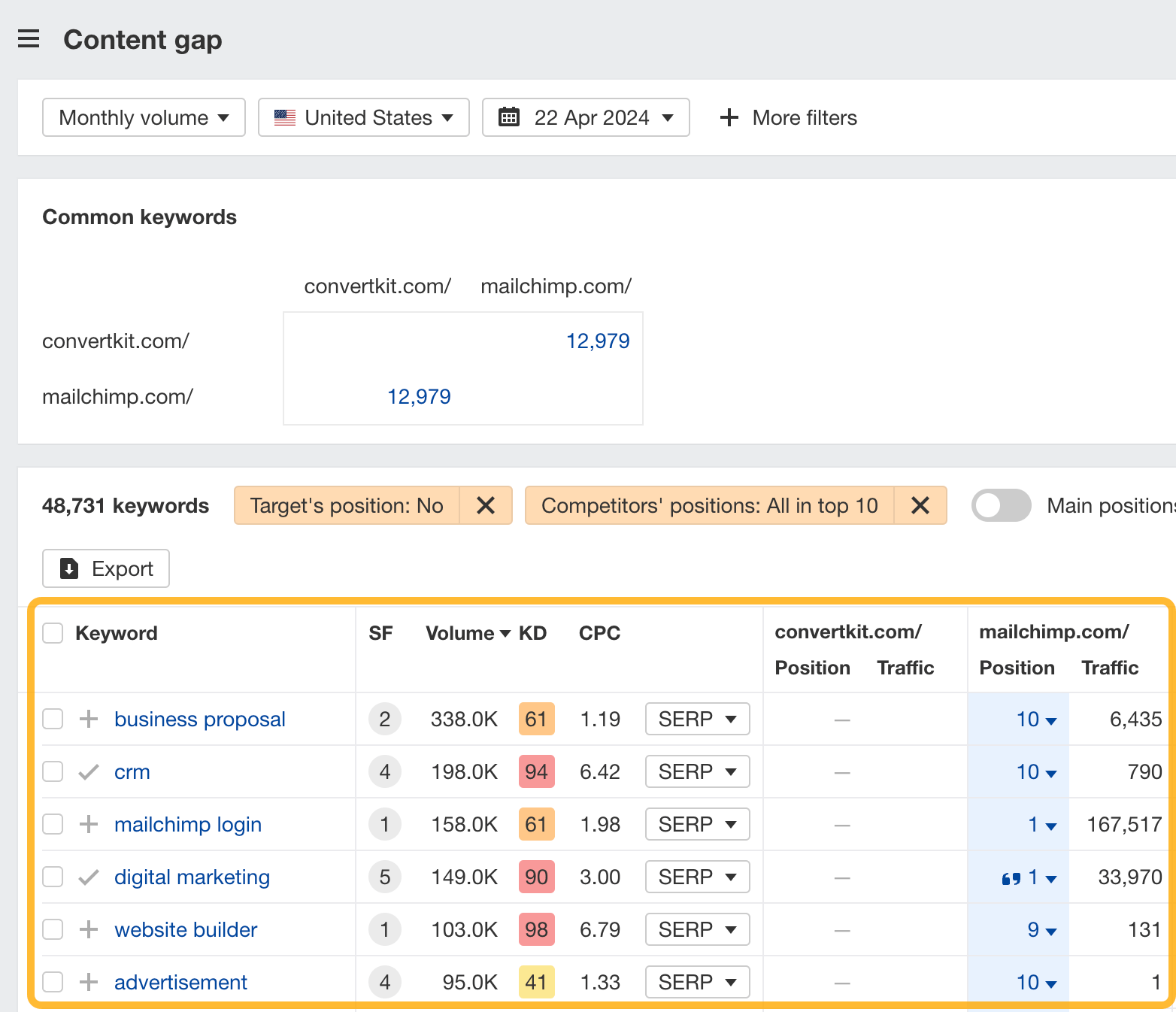

You can also add a Volume and KD filter to find popular, low-difficulty keywords in this report.
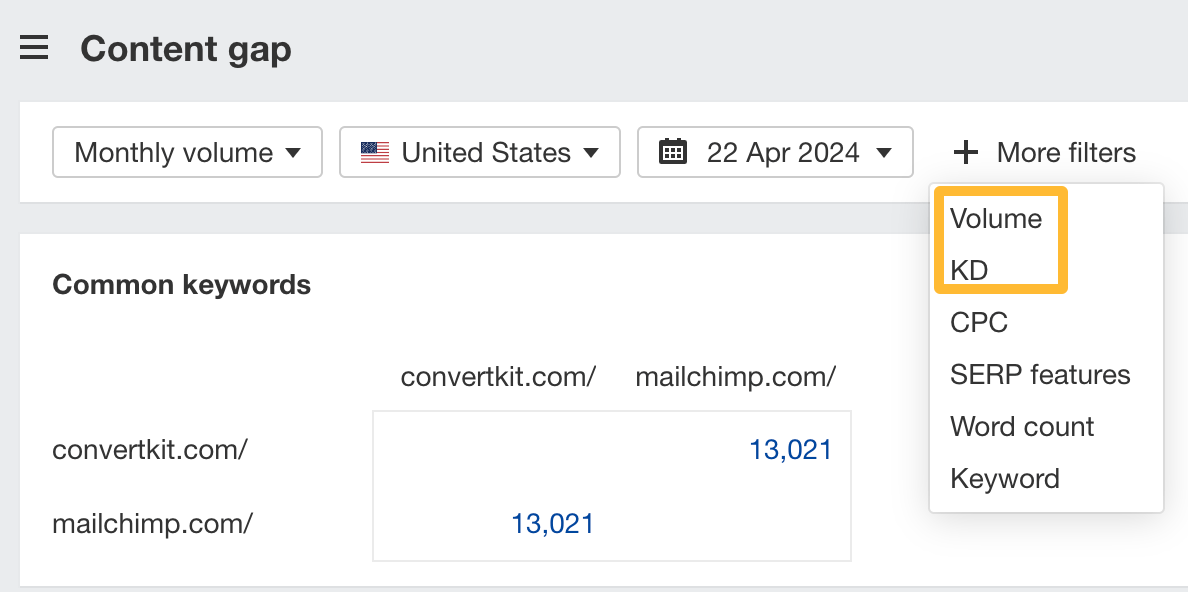

How to find keywords multiple competitors rank for, but you don’t
- Go to Competitive Analysis
- Enter your domain in the This target doesn’t rank for section
- Enter the domains of multiple competitors in the But these competitors do section
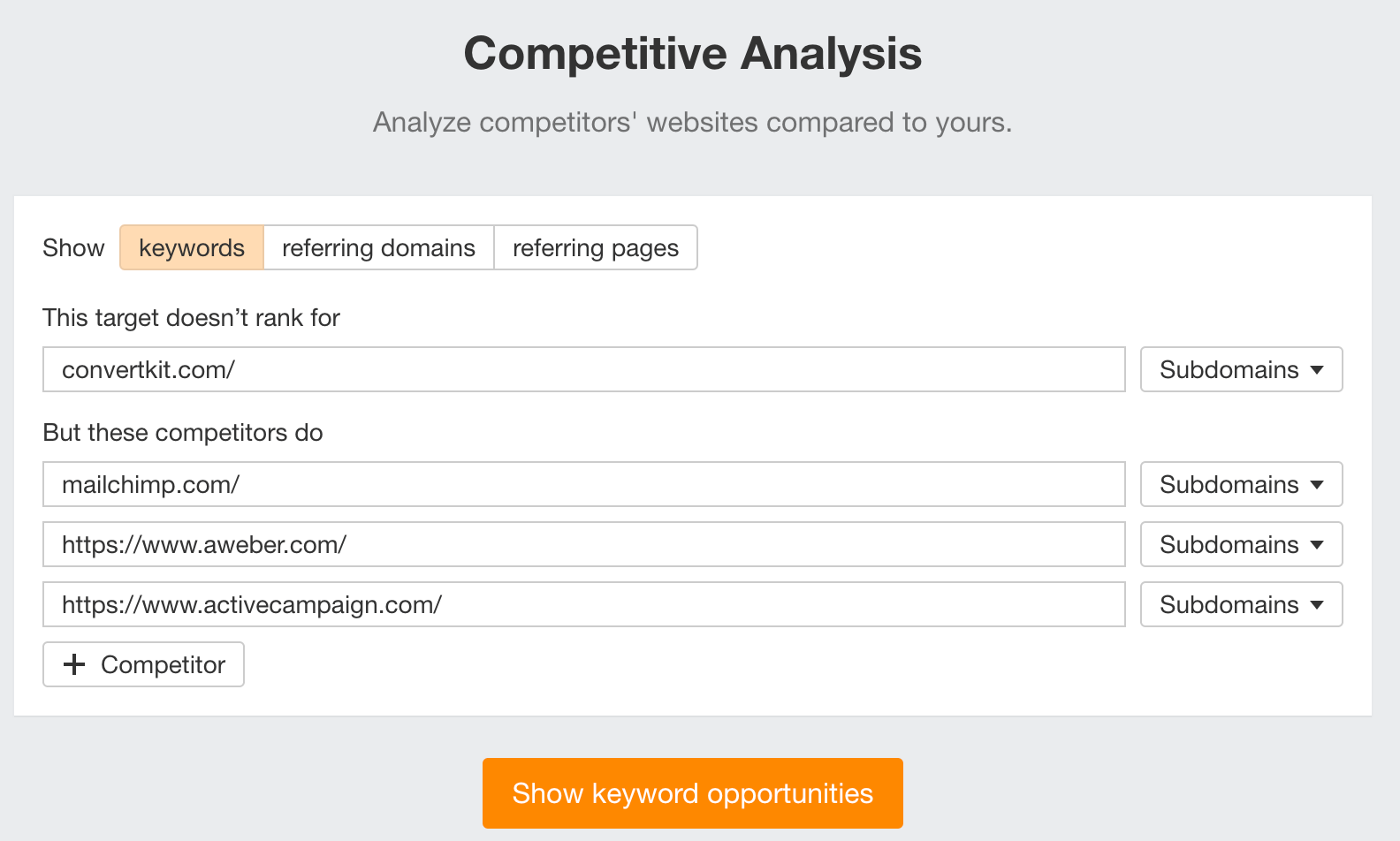

You’ll see all the keywords that at least one of these competitors ranks for, but you don’t.


You can also narrow the list down to keywords that all competitors rank for. Click on the Competitors’ positions filter and choose All 3 competitors:
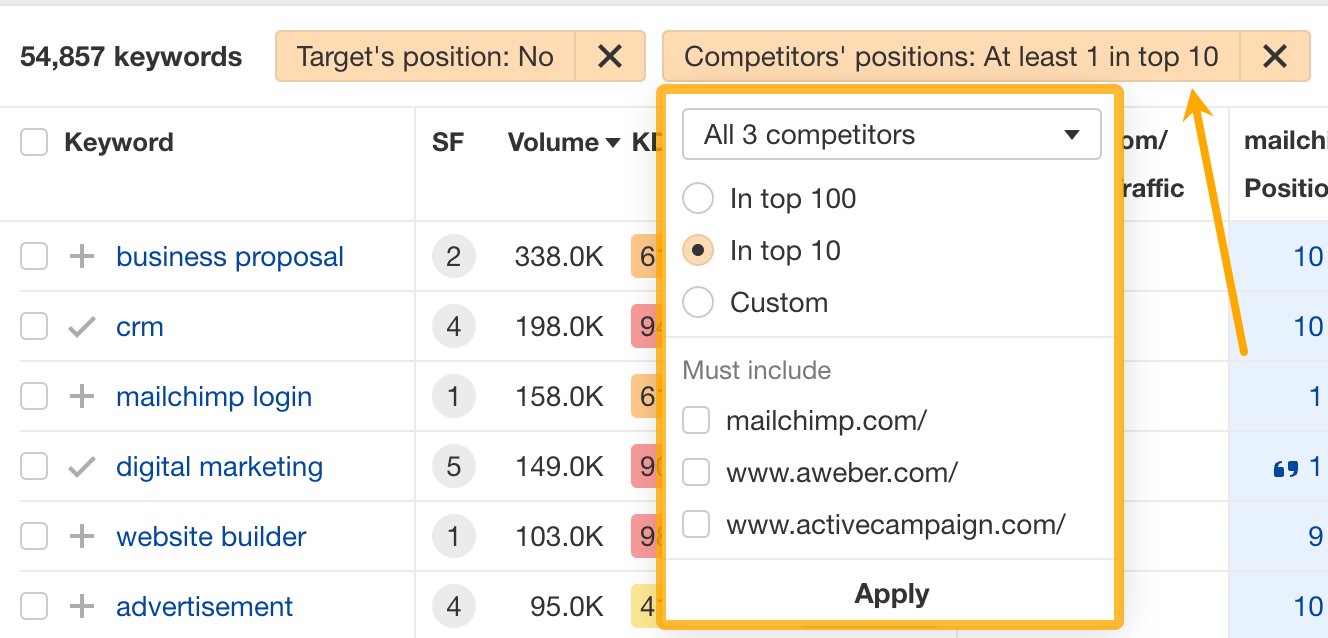

- Go to Ahrefs’ Site Explorer
- Enter your competitor’s domain
- Go to the Paid keywords report
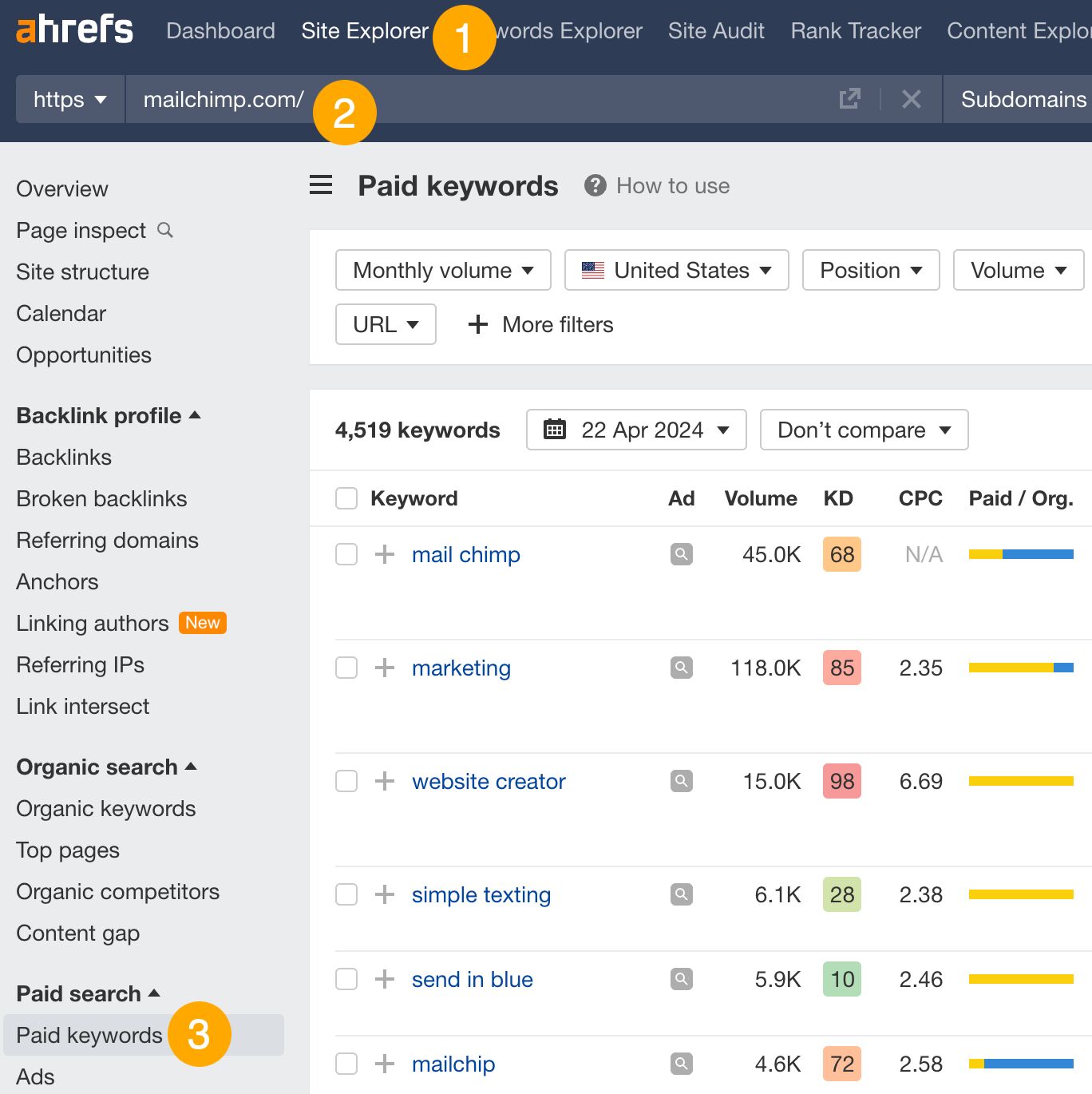

This report shows you the keywords your competitors are targeting via Google Ads.
Since your competitor is paying for traffic from these keywords, it may indicate that they’re profitable for them—and could be for you, too.
You know what keywords your competitors are ranking for or bidding on. But what do you do with them? There are basically three options.
1. Create pages to target these keywords
You can only rank for keywords if you have content about them. So, the most straightforward thing you can do for competitors’ keywords you want to rank for is to create pages to target them.
However, before you do this, it’s worth clustering your competitor’s keywords by Parent Topic. This will group keywords that mean the same or similar things so you can target them all with one page.
Here’s how to do that:
- Export your competitor’s keywords, either from the Organic Keywords or Content Gap report
- Paste them into Keywords Explorer
- Click the “Clusters by Parent Topic” tab
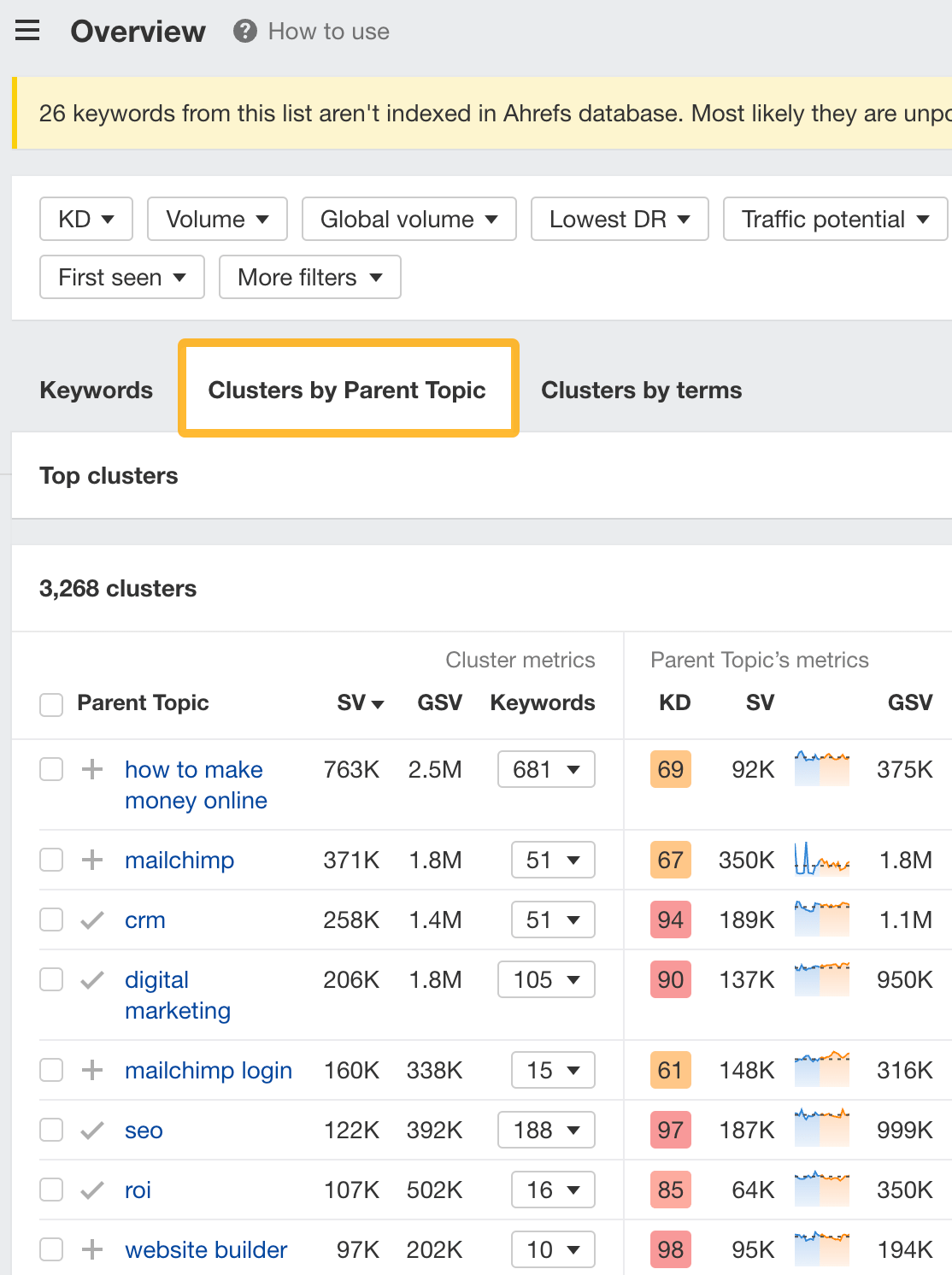

For example, MailChimp ranks for keywords like “what is digital marketing” and “digital marketing definition.” These and many others get clustered under the Parent Topic of “digital marketing” because people searching for them are all looking for the same thing: a definition of digital marketing. You only need to create one page to potentially rank for all these keywords.
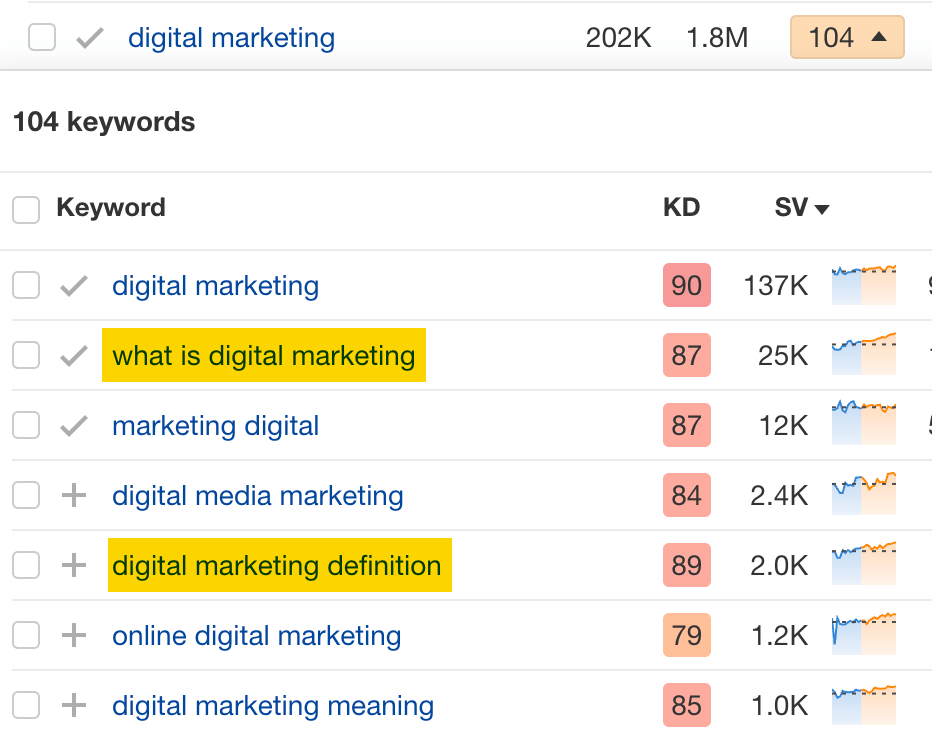

2. Optimize existing content by filling subtopics
You don’t always need to create new content to rank for competitors’ keywords. Sometimes, you can optimize the content you already have to rank for them.
How do you know which keywords you can do this for? Try this:
- Export your competitor’s keywords
- Paste them into Keywords Explorer
- Click the “Clusters by Parent Topic” tab
- Look for Parent Topics you already have content about
For example, if we analyze our competitor, we can see that seven keywords they rank for fall under the Parent Topic of “press release template.”


If we search our site, we see that we already have a page about this topic.


If we click the caret and check the keywords in the cluster, we see keywords like “press release example” and “press release format.”


To rank for the keywords in the cluster, we can probably optimize the page we already have by adding sections about the subtopics of “press release examples” and “press release format.”
3. Target these keywords with Google Ads
Paid keywords are the simplest—look through the report and see if there are any relevant keywords you might want to target, too.
For example, Mailchimp is bidding for the keyword “how to create a newsletter.”


If you’re ConvertKit, you may also want to target this keyword since it’s relevant.
If you decide to target the same keyword via Google Ads, you can hover over the magnifying glass to see the ads your competitor is using.
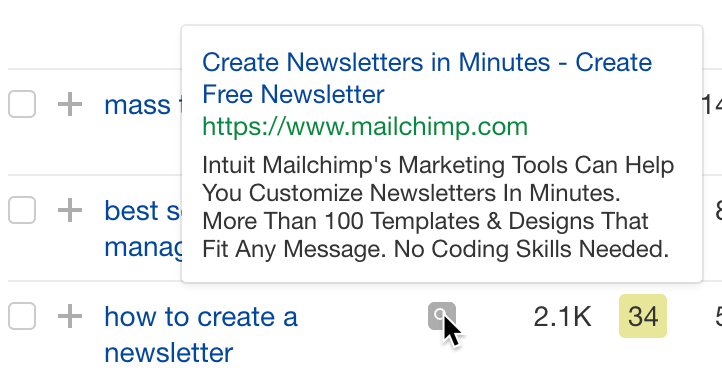

You can also see the landing page your competitor directs ad traffic to under the URL column.


Learn more
Check out more tutorials on how to do competitor keyword analysis:
SEO
Google Confirms Links Are Not That Important
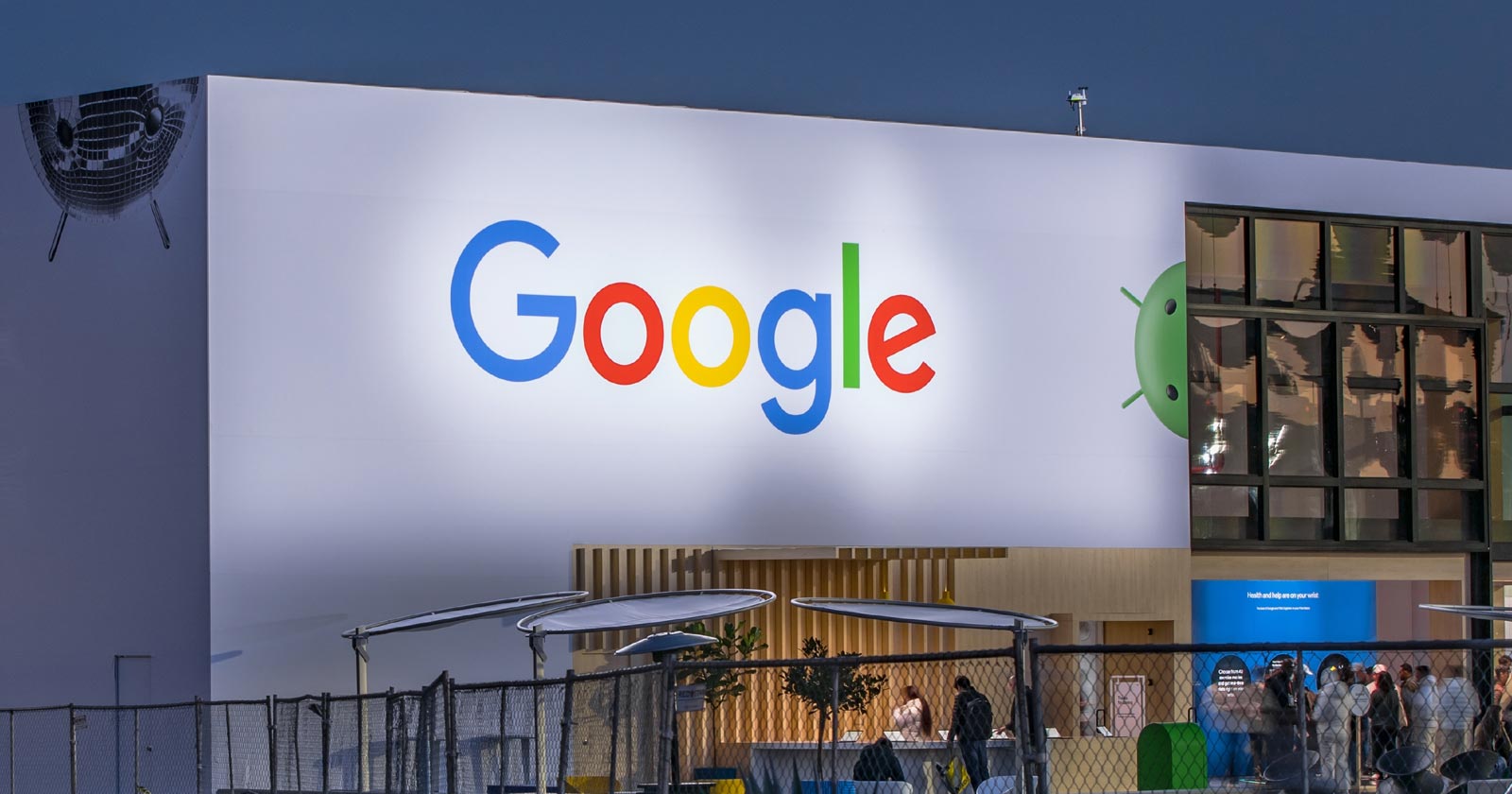
Google’s Gary Illyes confirmed at a recent search marketing conference that Google needs very few links, adding to the growing body of evidence that publishers need to focus on other factors. Gary tweeted confirmation that he indeed say those words.
Background Of Links For Ranking
Links were discovered in the late 1990’s to be a good signal for search engines to use for validating how authoritative a website is and then Google discovered soon after that anchor text could be used to provide semantic signals about what a webpage was about.
One of the most important research papers was Authoritative Sources in a Hyperlinked Environment by Jon M. Kleinberg, published around 1998 (link to research paper at the end of the article). The main discovery of this research paper is that there is too many web pages and there was no objective way to filter search results for quality in order to rank web pages for a subjective idea of relevance.
The author of the research paper discovered that links could be used as an objective filter for authoritativeness.
Kleinberg wrote:
“To provide effective search methods under these conditions, one needs a way to filter, from among a huge collection of relevant pages, a small set of the most “authoritative” or ‘definitive’ ones.”
This is the most influential research paper on links because it kick-started more research on ways to use links beyond as an authority metric but as a subjective metric for relevance.
Objective is something factual. Subjective is something that’s closer to an opinion. The founders of Google discovered how to use the subjective opinions of the Internet as a relevance metric for what to rank in the search results.
What Larry Page and Sergey Brin discovered and shared in their research paper (The Anatomy of a Large-Scale Hypertextual Web Search Engine – link at end of this article) was that it was possible to harness the power of anchor text to determine the subjective opinion of relevance from actual humans. It was essentially crowdsourcing the opinions of millions of website expressed through the link structure between each webpage.
What Did Gary Illyes Say About Links In 2024?
At a recent search conference in Bulgaria, Google’s Gary Illyes made a comment about how Google doesn’t really need that many links and how Google has made links less important.
Patrick Stox tweeted about what he heard at the search conference:
” ‘We need very few links to rank pages… Over the years we’ve made links less important.’ @methode #serpconf2024″
Google’s Gary Illyes tweeted a confirmation of that statement:
“I shouldn’t have said that… I definitely shouldn’t have said that”
Why Links Matter Less
The initial state of anchor text when Google first used links for ranking purposes was absolutely non-spammy, which is why it was so useful. Hyperlinks were primarily used as a way to send traffic from one website to another website.
But by 2004 or 2005 Google was using statistical analysis to detect manipulated links, then around 2004 “powered-by” links in website footers stopped passing anchor text value, and by 2006 links close to the words “advertising” stopped passing link value, links from directories stopped passing ranking value and by 2012 Google deployed a massive link algorithm called Penguin that destroyed the rankings of likely millions of websites, many of which were using guest posting.
The link signal eventually became so bad that Google decided in 2019 to selectively use nofollow links for ranking purposes. Google’s Gary Illyes confirmed that the change to nofollow was made because of the link signal.
Google Explicitly Confirms That Links Matter Less
In 2023 Google’s Gary Illyes shared at a PubCon Austin that links were not even in the top 3 of ranking factors. Then in March 2024, coinciding with the March 2024 Core Algorithm Update, Google updated their spam policies documentation to downplay the importance of links for ranking purposes.
The documentation previously said:
“Google uses links as an important factor in determining the relevancy of web pages.”
The update to the documentation that mentioned links was updated to remove the word important.
Links are not just listed as just another factor:
“Google uses links as a factor in determining the relevancy of web pages.”
At the beginning of April Google’s John Mueller advised that there are more useful SEO activities to engage on than links.
Mueller explained:
“There are more important things for websites nowadays, and over-focusing on links will often result in you wasting your time doing things that don’t make your website better overall”
Finally, Gary Illyes explicitly said that Google needs very few links to rank webpages and confirmed it.
I shouldn’t have said that… I definitely shouldn’t have said that
— Gary 鯨理/경리 Illyes (so official, trust me) (@methode) April 19, 2024
Why Google Doesn’t Need Links
The reason why Google doesn’t need many links is likely because of the extent of AI and natural language undertanding that Google uses in their algorithms. Google must be highly confident in its algorithm to be able to explicitly say that they don’t need it.
Way back when Google implemented the nofollow into the algorithm there were many link builders who sold comment spam links who continued to lie that comment spam still worked. As someone who started link building at the very beginning of modern SEO (I was the moderator of the link building forum at the #1 SEO forum of that time), I can say with confidence that links have stopped playing much of a role in rankings beginning several years ago, which is why I stopped about five or six years ago.
Read the research papers
Authoritative Sources in a Hyperlinked Environment – Jon M. Kleinberg (PDF)
The Anatomy of a Large-Scale Hypertextual Web Search Engine
Featured Image by Shutterstock/RYO Alexandre
SEO
How to Become an SEO Lead (10 Tips That Advanced My Career)
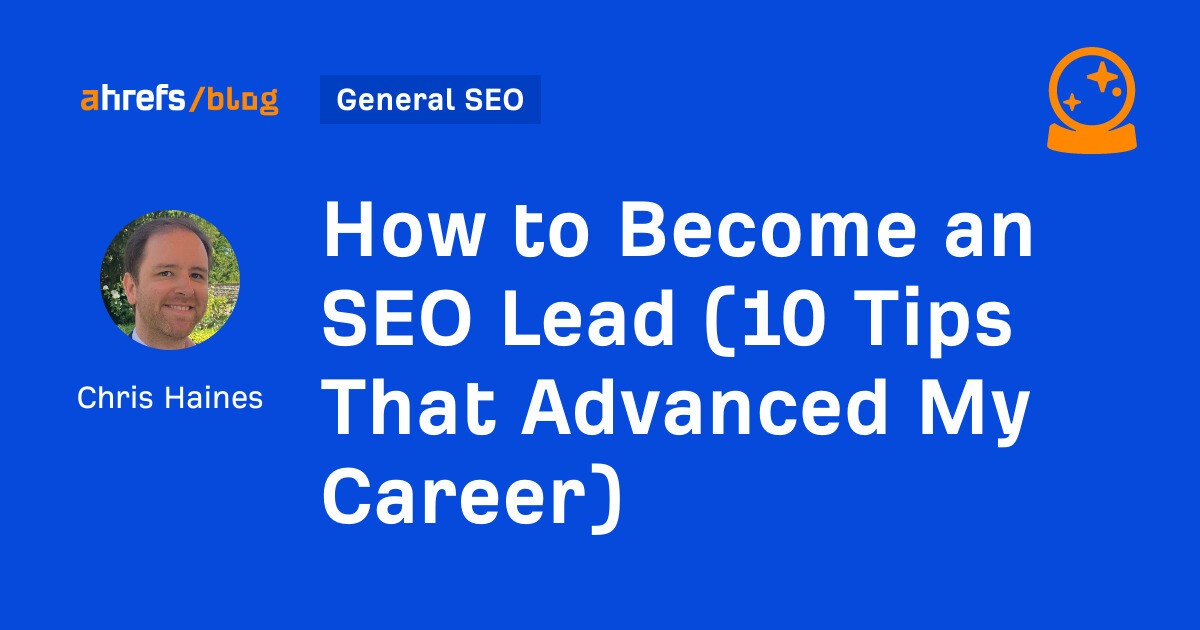
A few years ago, I was an SEO Lead managing enterprise clients’ SEO campaigns. It’s a senior role and takes a lot of work to get there. So how can you do it, too?
In this article, I’ll share ten tips to help you climb the next rung in the SEO career ladder.
Helping new hires in the SEO team is important if you want to become an SEO Lead. It gives you the experience to develop your leadership skills, and you can also share your knowledge and help others learn and grow.
It demonstrates you can explain things well, provide helpful feedback, and improve the team’s standard of work. It shows you care about the team’s success, which is essential for leaders. Bosses look for someone who can do their work well and help everyone improve.
Here are some practical examples of things I did early in my career to help mentor junior members of the team that you can try as well:
- Hold “lunch and learn” sessions on topics related to SEO and share case studies of work you have done
- Create process documents for the junior members of the team to show them how to complete specific tasks related to your work
- Compile lists of your favorite tools and resources for junior members of the team
- Create onboarding documents for interns joining the company
Wouldn’t it be great if you could look at every single SEO Lead’s resume? Well, you already can. You can infer ~70% of any SEO’s resume by spying on their LinkedIn and social media channels.
Type “SEO Lead” into LinkedIn and see what you get.

Tip
Look for common career patterns of the SEOs you admire in the industry.
I used this method to understand how my favorite SEOs and people at my company navigated their way from a junior role to a senior role.
For example, when the Head of SEO at the time Kirsty Hulse, joined my team, I added her on LinkedIn and realized that if I wanted to follow in her footsteps, I’d need to start by getting the role of SEO Manager to stand any possible chance of leading SEO campaigns like she was.
The progression in my company was from SEO Executive to Senior SEO Executive (Junior roles in London, UK), but as an outsider coming into the company, Kirsty showed me that it was possible to jump straight to SEO Manager given the right circumstances.


Using Kirsty’s and other SEOs’ profiles, I decided that the next step in my career needed to be SEO Manager, and at some point, I needed to get some experience with a bigger media agency so I could work my way up to leading an SEO campaign with bigger brands.
Sadly, you can’t just rock up to a monthly meeting and start leading a big brand SEO campaign. You’ll need to prove yourself to your line manager first. So how can you do this?
Here’s what I’d suggest you do:
- Create a strong track record with smaller companies.
- Obsessively share your wins with your company, so that senior management will already know you can deliver.
- At your performance review, tell your line manager that you want to work on bigger campaigns and take on more responsibility.
If there’s no hope of working with a big brand at your current job, you might need to consider looking for a new job where there is a recognizable brand. This was what I realized I needed to do if I wanted to get more experience.
Tip
Get recruiters on LinkedIn to give you the inside scoop on which brands or agencies are hiring. Ask them if you have any skill gaps on your resume that could prevent you from getting a job with these companies.
Being critical of your skill gaps can be hard to do. I found the best way to identify them early in my career was to ask other people—specifically recruiters. They had knowledge of the industry and were usually fairly honest as to what I needed to improve.
From this, I realized I lacked experience working with other teams—like PR, social, and development teams. As a junior SEO, your mind is focused 99% on doing SEO, but when you become more senior, your integration with other teams is important to your success.
For this reason, I’d suggest that aspiring SEO Leads should have a good working knowledge of how other teams outside of SEO operate. If you take the time to do this, it will pay dividends later in your career:
- If there are other teams in your company, ask if you can do some onboarding training with them.
- Get to know other team leads within your company and learn how they work.
- Take training courses to learn the fundamentals of other disciplines that complement SEO, such as Python, SQL, or content creation.
Sometimes, employers use skill gaps to pay you less, so it’s crucial to get the skills you need early on…


Examples of other skill gaps I’ve noticed include:
Tip
If you think you have a lot of skill gaps, then you can brush up your skills with our SEO academy. Once you’ve completed that, you can fast-track your knowledge by taking a course like Tom Critchlow’s SEO MBA, or you can try to develop these skills through your job.


As a junior in any company, it can be hard to get your voice heard amongst the senior crowd. Ten years ago, I shared my wins with the team in a weekly group email in the office.
Here’s what you should be sharing:
- Praise from 3rd parties, e.g. “the client said they are impressed with the work this month.”
- Successful performance insights, e.g “following our SEO change, the client has seen X% more conversions this month.”
- Examples of the work you led, e.g. if your leadership and decision-making led to good results, then you need to share it.
At Ahrefs I keep a “wins” document. It’s just a simple spreadsheet that lists feedback on the blog posts I’ve written, the links I’ve earned and what newsletters my post was included in. It’s useful to have a document like this so you have a record of your achievements.


Sidenote.
Junior SEOs sometimes talk about the things “we” achieved as a team rather than what they achieved at the interview stage. If you want the SEO Lead role, remember to talk about what you achieved. While there’s no “I” in team, you also need to advocate for yourself.
One of my first big wins as an SEO was getting a link from an outreach campaign on Buzzfeed. When I went to Brighton SEO later that year and saw Matthew Howells-Barby sharing how he got a Buzzfeed link, I realized that this was not something everyone had done.
So when I did manage to become an SEO Lead, and my team won a prize in Publicis Groupe for our SEO performance, I made sure everyone knew about the work we did. I even wrote a case study on the work for Publicis Groupe’s intranet.


I’ve worked with some incredibly talented people, many of whom have helped me in my career.
I owe my big break to Tim Cripps, Laura Scott, and Kevin Mclaren. Without their support and encouragement, I wouldn’t be where I am today. Even before that, David Schulhof, Jodie Wheeler, and Carl Brooks let me mastermind some bonkers content campaigns that were lucky enough to succeed:


I wasn’t even an SEO Lead at that point, but they gave me the reins and trusted me.
So, how can you find your tribe?
- Speak to recruiters – they might hold the ticket to your next dream job. I spoke to many recruiters early in my career, but only two recruiters delivered for me—they were Natasha Woodford, and Amalia Gouta. Natasha helped me get a job that filled my skill gap, and Amalia helped me get my first SEO Lead role.
- Go to events and SEO conferences, and talk to speakers to build connections outside of your company.
- Use LinkedIn and other social media to interact with other companies or individuals that resonate with you.
Many senior SEO professionals spend most of their online lives on X and LinkedIn. If you’re not using them, you’re missing out on juicy opportunities.


Sharing your expertise on these platforms is one of the easiest ways to increase your chances of getting a senior SEO role. Because, believe it or not, sometimes a job offer can be just a DM away.
Here’s some specific ideas of what you can share:
- Share your thoughts on a trending topic – like the latest Google algorithm update.
- Share what you learned during the course of a campaign.
- Ask the community for their thoughts on a certain topic.
I’ve recently started posting on LinkedIn and am impressed by the reach you can get by posting infrequently on these topics.
Here’s an example of one of my posts where I asked the community for help researching an article I was writing:


And here is the content performance across the last year from posting these updates.


I’m clearly not a LinkedIn expert—far from it! But as you can see, with just a few months of posting, you can start to make these platforms work for you.
Godard Abel, co-founder of G2, talked on a podcast about conscious leadership. This struck a chord with me recently as I realized that I had practiced some of the principles of conscious leadership—unconsciously.
You can start practicing conscious leadership by asking yourself if your actions are above or below the line. Here are a few examples of above and below-the-line thinking:


If you want a senior SEO role, I’d suggest shifting your mindset to above-the-line thinking.
In the world of SEO, it’s easy to blame all your search engine woes on Google. We’ve all been there. But a lot of the time, simple changes to your website can make a huge difference—it just takes a bit of effort to find them and make the changes.
SEO is not an exact science. Some stakeholders naturally get nervous if they sense you aren’t sure about what you’re saying. If you don’t get their support early on then you fall at the first hurdle.


To become more persuasive, try incorporating Aristotle’s three persuasive techniques into your conversations.
- Pathos: use logical reasoning, facts, and data to present water-tight arguments.
- Ethos: establish your credibility and ethics through results.
- Logos: make your reports tell a story.


Then sprinkle in language that has a high level of modality:


Some people will be able to do this naturally without even realizing it, but for others, it can be an uphill struggle. It wasn’t easy for me, and I had to learn to adapt the way I talked to stakeholders early on.
The strongest way I found was to appeal to emotions and back up with data from a platform like Ahrefs. Highlight what competitors have done in terms of SEO and the results they’ve earned from doing it.
Sidenote.
You don’t have to follow this tip to the letter, but being aware of these concepts means you’ll start to present more confident and persuasive arguments for justifying your SEO strategies.
When I started in SEO, I had zero connections. Getting a job felt like an impossible challenge.
Once I’d got my first SEO Lead job, it felt stupidly easy to get another one—just through connections I’d made along the way in my SEO journey.
I once got stuck on a delayed train with a senior member of staff, and he told me he was really into Google Local Guides, and he was on a certain high level. He said it took him a few years to get there.
Local Guides is part of Google Maps that allows you submit reviews and other user generated content
When he showed me the app, I realized that you could easily game the levels by uploading lots of photos.
In a “hold my beer” moment, I mass downloaded a bunch of photos, uploaded them to Local Guides and equaled his Local Guide level on the train in about half an hour. He was seething.


One of the photos I uploaded was a half-eaten Subway. It still amazes me that 50,974 people have seen this photo:


This wasn’t exactly SEO, but the ability to find this ‘hack’ so quickly impressed him, and we struck up a friendship.
The next month that person moved to another company, and then another few months later, he offered me an SEO Lead job.
Tip
Build connections with everyone you can—you never know who you might need to call on next.
Final thoughts
The road to becoming an SEO Lead seems straightforward enough when you start out, but it can quickly become long and winding.
But now armed with my tips, and a bucket load of determination, you should be able to navigate your way to an SEO Lead role much quicker than you think.
Lastly, if you want any more guidance, you can always ping me on LinkedIn. 🙂
-

 PPC4 days ago
PPC4 days ago19 Best SEO Tools in 2024 (For Every Use Case)
-

 PPC7 days ago
PPC7 days ago4 New Google Ads Performance Max Updates: What You Need to Know
-

 MARKETING7 days ago
MARKETING7 days agoWill Google Buy HubSpot? | Content Marketing Institute
-
SEARCHENGINES6 days ago
Daily Search Forum Recap: April 16, 2024
-

 SEO6 days ago
SEO6 days agoGoogle Clarifies Vacation Rental Structured Data
-

 MARKETING6 days ago
MARKETING6 days agoStreamlining Processes for Increased Efficiency and Results
-
SEARCHENGINES5 days ago
Daily Search Forum Recap: April 17, 2024
-

 PPC7 days ago
PPC7 days agoHow to Collect & Use Customer Data the Right (& Ethical) Way














You must be logged in to post a comment Login